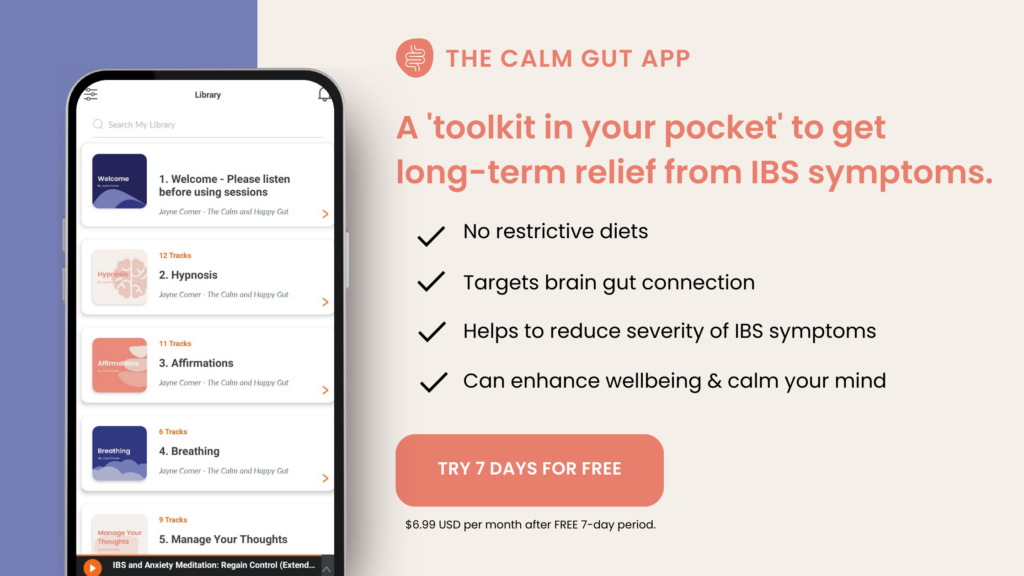One of the many challenging aspects of having gut and bowel issues is actually knowing what is going on. Why are you experiencing symptoms of pain, bloating, constipation, diarrhea, gas, nausea and fatigue? What’s happening inside of your body? Are these symptoms due to IBS (Irritable Bowel Syndrome) or are they symptoms of something else such as IBD (Inflammatory Bowel Disease)?
In this post and in the video below, I’ll be helping you understand the key differences in symptoms between IBS and IBD, and the red flags to look out for to seek additional medical attention.
Because when it comes to understanding what’s happening inside of your bowel, it can get pretty confusing.
Many people with Irritable Bowel Syndrome are concerned that they have been misdiagnosed – they believe that they have something called Inflammatory Bowel Disease (IBD) and not IBS.
Google certainly doesn’t help things, and the fact that the names of these two gut disorders are so similar also doesn’t help the confusion.
So let’s start with understanding what is IBS?
What is Irritable Bowel Syndrome IBS?
IBS (Irritable Bowel Syndrome) affects 10-15% of the adult population and is something called a functional disorder.
This means that there is no physical or structural damage to your bowel. For example, if you were to somehow shrink yourself down and take a look around inside of your intestines, you would find everything looking pretty normal.
Now the common symptoms of IBS are bloating, gas, abdominal pain, constipation and/or diarrhea, and the diagnosis of IBS should be made by your doctor – not by self-diagnosis!
Your doctor will consider the diagnosis of IBS if you have experienced the symptoms of abdominal pain or discomfort, bloating, or a change in bowel habit for more than 6 months.
In addition, an IBS diagnosis is usually only considered if you have abdominal pain that is relieved by passing a stool or there is altered bowel frequency (for example, constipation or diarrhea) and at least 2 symptoms from:
- Altered stool passage (meaning straining, urgency or what we call incomplete evacuation)
- Abdominal bloating, distention (which means visible bloating), tension or hardness
- Symptoms made worse by eating
- Passing mucus
Now unfortunately the diagnosis of IBS is what we call a diagnosis of exclusion – meaning there is no specific test for IBS itself, and it’s diagnosed based on what I’ve already covered above, and by excluding other conditions.
The reason there is no test for IBS, is because as I explained a little earlier, there is actually no physical damage to the gut so there is nothing we can test for. At least not at this point in time.
(You can read more about how your doctor can diagnose IBS in this post: How is IBS Diagnosed? 5 Tests Your Doctor May Recommend)
So now we’ve talked about IBS, let’s look at IBD.
What is Inflammatory Bowel Disease (IBD)?
IBD stands for Inflammatory Bowel Disease and is completely different from IBS. It is also less common, with estimates of around 1% of the adult population affected by it.
Now before I dive into what IBD is I want to clear up a common misunderstanding, and that is thinking that IBS turns into IBD or even colon cancer.
This is not true. IBS does not turn into anything dangerous or life-threatening. IBS is a very different gut disorder.
Now with that said, let me explain the two different types of IBD.
The two types of Inflammatory Bowel Disease (IBD)
Crohn’s Disease and Ulcerative Colitis are the two types of Inflammatory Bowel Disease and they are often characterised as autoimmune disorders.
This means that they develop because the body starts to attack itself, causing inflammation of the GI tract (which runs from your mouth all the way down to your anus).
This is the first big difference with IBS – which is not an autoimmune disorder.
Also, unlike IBS, Crohn’s disease and Ulcerative Colitis are characterised by inflammation in your gastrointestinal tract.
So for example people with Crohn’s disease may have ulcers and inflammation anywhere from their mouth to their anus.
However, with Ulcerative Colitis, the inflammation is limited to the large intestine.
This inflammation allows IBD to be diagnosed with tests such as a colonoscopy as there is physical damage to the bowel, unlike in IBS.
How do you know if you have Inflammatory Bowel Disease?
So now you know what IBD is, and some of the key differences with IBS, let’s talk about the symptoms you need to be aware of and what I call red flags.
Let’s start with Crohn’s disease.
The signs of Crohn’s disease
Symptoms of Crohn’s disease depend on where in the GI tract you have inflammation.
Half of all people who have Crohn’s disease have the disease of the small intestine and large intestine, with approximately 1/3 having Crohn’s limited to just their small intestine.
Common signs include:
- abdominal pain
- loose stools
- occasional low grade fevers
- fatigue
- blood in your stool
- weight loss
In addition, you may also notice inflammation in other seemingly unrelated areas such as the eyes, experiencing back pain and arthritis, ulcers in the mouth, and also skin ulcers.
Anaemia is also an indication of Crohn’s which can be picked up via a blood test.
The Signs of Ulcerative Colitis
With Ulcerative Colitis the symptoms are very similar:
- abdominal pain
- loose and/or bloody stools
- the urgency of a bowel movement
- fatigue
- loss of appetite and weight loss
These symptoms are also not typical of IBS, and point to something which needs to be addressed ASAP by your doctor.
So what are the most important red flags?
The red flags or warning signs you need to be aware of are:
- Unintentional and unexplained weight loss
- Rectal bleeding – which can be seen as blood in your stool or blood when wiping
- Anemia – usually felt when you’re feeling fatigued and really low on energy
- Abdominal or rectal lumps
- And raised inflammatory markers – which are determined by a blood test and sometimes can be experienced physically, for example as skin problems such as rashes, or joint pain.
Now I get it, gut stuff can be really embarrassing and awkward to talk about. I know it’s easier to want to just put your head in the sand and hope your symptoms just go away.
But please don’t do this.
Your body is giving a very clear sign that all is not ok. It is therefore vitally important that if you experience any of the red flags I’ve covered that you speak to your doctor ASAP.
Because there is plenty of help out there for you and knowing what’s going on inside your gut rather than guessing, means that you can start to manage your symptoms.
I’m here to help
If you’d like to explore whether hypnotherapy for IBS and my Calm Gut Program is the right approach for you, then book a free 30 minute consultation. With almost 40 years of solid evidence behind it, gut directed hypnotherapy has been shown to reduce IBS symptoms in more than 70-80% of people. In this free 30 minute call, we will discuss:
- Your current IBS symptoms, health history and challenges you’re experiencing
- What you’ve already tried to get relief from IBS and why you’re still stuck
- How hypnosis for IBS (also known as gut directed hypnotherapy) works and determine a program of therapy going forward.
If you have any questions before booking this call, you can contact me here.

